Text
Artist Statement v2
Dichotomy is a dissolution of the typical heroic narrative. It questions perceived oppositions between the natural and artificial world, how cultures and individuals have encoded the world into binary oppositions, and the unreachability of absolute truth. It serves as a record of a personal transformation that has and is happening over the course of several years, and as an ongoing conversation, it will change as it progresses.
Dichotomy is meant to exist between several narratives of the archetypical hero and the world they inhabit, but primarily draws from a intersection between the ideologies of Buddhism, Christianity, and Materialism.
Pen and ink is the medium for Dichotomy. Ink on paper creates an opposition of absolute dark and light, yet has the illusion of a full range of value. The conflict of illusion and reality mirrors the wider disparity between truth and perception.
0 notes
Text
Question of the Week #12
Q: Have you had to make sacrifices in order to live your life as an artist?
A: Learning any skill takes a sacrifice of time and effort, but art, especially conceptual art, taxes in new and unforeseen ways.
The creative process is not an easy one to undertake, but to translate skills into meaning is a special kind of work that not only requires a lot of time, thought, and self-reflection, but changes you as a person. To be an artist is not only to create work, but take up a kind of responsibility for that work. It not only shapes action, but identity.
Taking my creativity, my experiences, my own body and mind, and using them to create expressive things has formed itself into part of my own soul. A great part of me has been devoted to the process of exploration and creation of my work, at the expense of many other practices and identities I could have taken instead.
Beyond the obvious sacrifices of creation is a deeper and more fulfilling devotion of one’s very being to art. It is not the easiest path, but it is certainly an exciting and fulfilling one.
1 note
·
View note
Text
Question of the Week #11
Q: Have there been any distinct experiences that have steered your work in new or significant directions?
A: To be perfectly honest, my method of creation has changed very little from when it began. My artistic journey has always been one of trying to perfect the same methods. Rather, it’s been the concepts at play within the framework of images, themes, and ideas that are in flux. I have always been creating worlds, but the worlds change quite drastically, yet remain subtly connected. One could argue that I have been working on the same framework of a world since creative inception. One could even say the thematic tendencies of the stories I create have remained more or less in the same direction.
Yet there have been drastic changes to both myself and my art since I’ve moved away from my childhood home. The instability, changes I have never really contended with before, have thrown much of what I personally believed, understood, and trusted about the world has been thrown to the wind. My worlds and methods of expressing them have also been transforming.
What was once bedrock has become an ocean, and I do not think what I make, or who I am, will ever be the same.
0 notes
Text
Question(s) of the Week #10 (2)
Q: What do you expect from your art education?
A: When I went into the art classroom, I expected to be drilled into new techniques, primarily to build technical skills. How to copy, how to use perspective, how to properly shade, etc. What resulted was a combination of lite skill-building with an exploration of conceptual art. This was quite unexpected, even discouraging, but in retrospect, it was at least partially worth it.
My answer to an art education’s expectations is skills, connections, and know-how. What ended up happening was an unexpected experience of getting to brush with the conceptual art space. While it’s certainly enriching, it isn’t all I want.
Thankfully, skill-building and getting know-how is an activity that can be pursued outside the classroom.
0 notes
Text
Question(s) of the Week #10 (1)
Q: What do you think are the most interesting things happening in art now?
A: Something I find endlessly compelling but equally difficult is the interaction of art pieces and their audience, especially regarding public art. To many outside the ‘modern-art-o-sphere,’ most conceptual art seems useless, impenetrable, or unnecessarily esoteric.
In fact, most nonartists I personally know regard modern art quite negatively. Compared to popular art, which they perceive as easier to understand, conceptual art can come off as made to appear ‘sophisticated,’ ‘abstract,’ or ‘deep’ with no greater purpose beyond a facade. Conceptual art’s withholding of ease of reading, at least compared to popular art (which I know from experience is primarily made to push effortlessly recognized messages) is jarring and off-putting to many, even to the point of considering it inherently unskilled and ‘hack’ compared to much popular/commercial art.
And even with some understanding of conceptual art, I sometimes find myself drifting to the same conclusions. Art in the gallery setting can certainly be overdone, pretentious, or faking depth. There are times I look at many public art pieces, even ones that are well received, and find myself rolling my eyes.
I notice that my happy medium tends to lie in a space between popular and conceptual art, such as ‘artsy’ films, video games, books, etc. While I can appreciate gallery art for what it is, I’m still unsure that’s a space I would consider ‘mine,’ and an issue I constantly have to retackle again and again is what it means to have a line, however fine, between the ‘commercial’ and the ‘conceptual’ spheres of art.
How and where they intercept and draw apart is where my interest lies.
0 notes
Text
Artist Statement
Dichotomy explores the necessity and difficulty of undergoing change. It follows a transition from a world of absolutes, to a world of incomprehension, to a world of possibility. Dichotomy mirrors an active and ongoing conflict in reality, and seeks to reveal the changes I see in the world at large and within my own experience.
Instead of a fully planned narrative, Dichotomy is created continuously, working off a framework of memory and impressions both from the minds of the characters and those of the author. Change takes new and unexpected forms as it progresses, and Dichotomy’s style, plot, and themes should shift over time to express this.
As it stands, I have chosen bare ink as Dichotomy’s medium, as it expresses an absolute dark and light. Though a full range of value can be found on the pages of Dichotomy, it is only formed by an optical illusion. The reader fills in the gaps, placing their own nuances into a medium that can only exist in dualistic conflict: an active, enforced reduction of all things to two ideals that, through their reduction, necessarily render themselves unstable.
I have also taken significant inspiration from dualistic ideas across the globe, in everything from iconography, propaganda, architecture, to the occult traditions of various religions. I have done this because Dichotomies exist at all levels in practically every human culture, and it appears that creating these polarized understandings of the world is, at some level, intrinsic to humans.
What that personally means, and where it must go, is yet to be seen.
1 note
·
View note
Photo
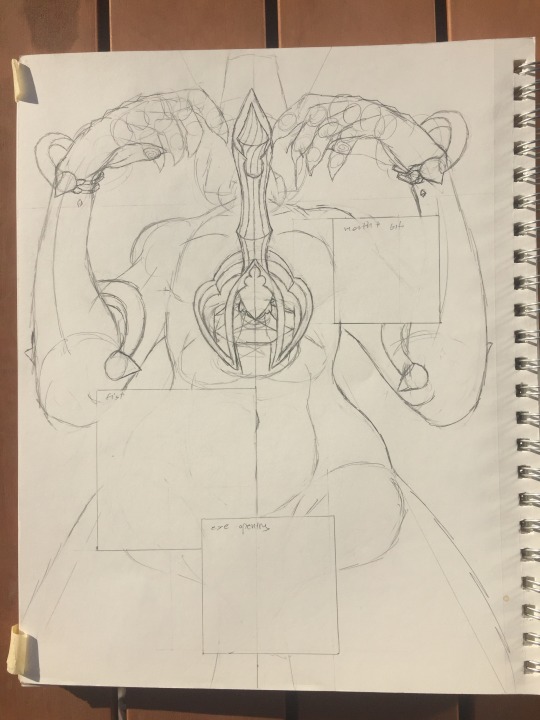
STUDIO UPDATE #3 (three)
Well it only took three weeks, but I’ve settled on a script for the first few pages, and began making serious progress on page 1. Above is page 1′s initial linework. Since some of the background work for it is gone, I’ll show you a previous iteration’s metamorphosis before I decided to drop it.
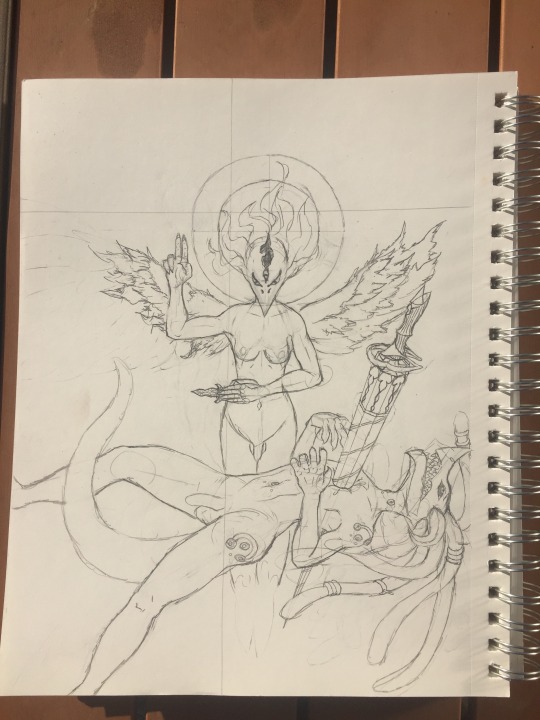
Above is the progress I had made on page 1′s third draft before shafting it as ‘too esoteric, weird, confusing, etc’ and settled for something a bit more recognizable to most readers. You’ll see when I come in with a couple completed pages on critique day.
So what’s the background to this? How do I make this from mind machinery?

The answer lies in iteration. A friend of mine recently gave me some ideas about thumbnailing and iterative concept-realization, and I decided to put a bit of what I’d heard into practice. He said you begin with five, and from one of those five, create another five variations of it. This not only gives you an idea of what will be in the page ideally, but also gives you snapshots into the actual layout and composition of the final piece. I can confirm it’s been an excellent tool, and every page will likely have this process behind it.
However, improving my preprocess is not all I’ve decided to work on.
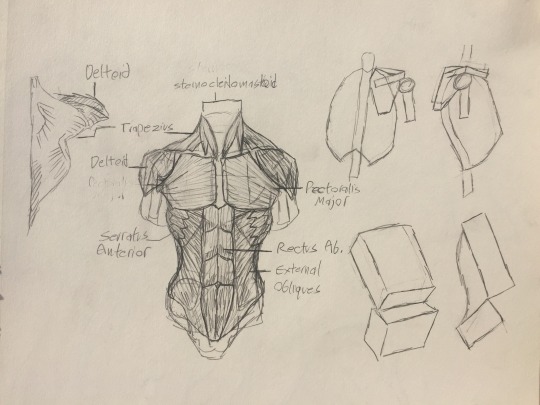
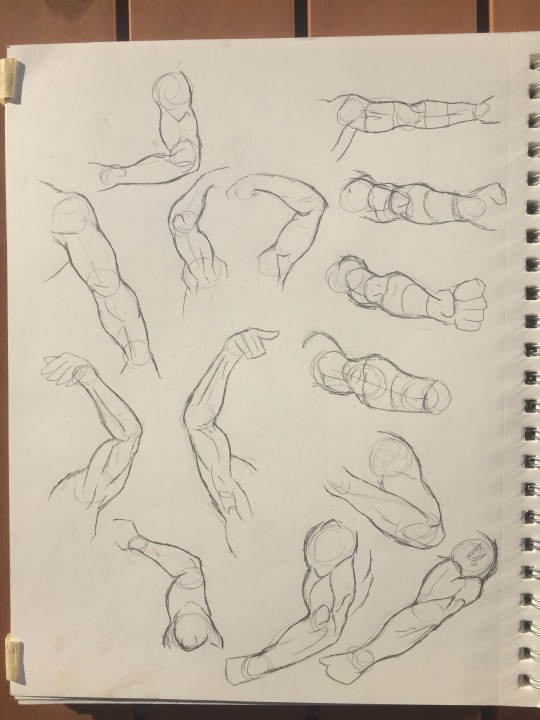

I’ve also decided to do some work on my anatomy. I think that’s the jump between a hobbyist and an artist serious about making something of themselves. I’m a lazy idiot most of the time, but taking an hour every day to work on my skills has already gone a long, long way.
1 note
·
View note
Text
Question(s) of the Week #9 (2)
Q: Do you think the intellectualizing of visual art by the artist or viewer lessens its power and emotional impact?
A: I would call any judgement of this scale a fundamentally strawman argument, but I’m sad to say all my arguments are strawmen, so that would be a copout.
I think the entire premise of this argument comes down to what one believes ‘power’ and ‘emotional impact’ are. One can’t deny they exist, but to say they exist the same way for everyone couldn’t be done in good faith.
That isn’t to say that people’s perceptions and reactions are so different that general notions of what constitutes ‘power and emotional impact’ can’t exist. Rather, taking one approach to power and emotional impact is a flawed model.
This is where ‘intellectualization’ can become an issue. Susan Sontang’s essay “Against Interpretation” posits that attempting to find ‘content’ first and foremost in an art piece turns appreciating art for what it is into a hunt for some hidden meaning. I can’t help but draw a parallel between this form of criticism and Qanon nutjobs attempting to find esoteric meanings in patterns of capitalization and spelling errors in Donald J. Trump’s twitter posts.
Of course, there is legitimate backing for theories of art criticism, and such a comparison is unfair, but I do wonder if imprinting these theories onto art is making a piece do things it was not meant to do, as far as the author’s intent even matters. Or perhaps it is some greater force of intent that assigns an art piece it’s ‘meaning,’ one that transcends theories and impacts and rather lies within human perception as a whole.
We make patterns out of everything, as is our nature. That tendency, no, that absolute drive, is what gives rise to all human thought and behavior. Theories of criticism could be called attempts at finding the patterns encoded in a work, whether intended, projected, or otherwise implied.
However, when that becomes the focus of art, when ‘decoding’ an art piece becomes the primary popular motive of art, then does that leave space for the instinctual connections to a piece that lie below, above, and alongside an intellectual connection?
0 notes
Text
Question(s) of the Week #9 (1)
Q: How will you know when you have arrived?
A: When will I have arrived? Arrived where?
So vague. Less of a question, and more of a request. A request for you to create the question as well as the answer.
I have been thinking about this ‘question’ for a week, and I still don’t have a good answer to what its even asking me, or rather, what I am asking myself. I can narrow the margins some, though.
The context dictates an arrival regarding specifically my creative journey, and to call the act of a creation a single journey is too reductive even for me. Creation isn’t really an action, or a mindset, or a lifestyle. It’s just part of you, and it expresses itself in everything you do.
How can you arrive when the very act of living itself is within the creative journey?
You could say that you die, but the impressions you leave within others continue the creative journey past the death of the author. Even if it isn’t explicitly remembered, your art outlasts you.
Perhaps you could say that an arrival is the attainment of a milestone or a breakthrough, the recurrence of The Tower in your Tarot deck, but that is not a true arrival. I would argue there is no true arrival until every last trace of you and your work is gone from the minds and the physical world for good.
Now if I could just complete one page of this project, I’d be happy to lay down my pencil forever and step right into a coffin.
0 notes
Text
Question(s) of the Week #8 (2)
Q: Do you have a motto?
A: No, I don’t really have a motto. But I do have catchphrases. Little isms that pop into my head and stay for awhile. I try to fit them into my stories sometimes.
“THE EYE OF GOD IS BLOODSHOT.“
“Everything is cracked in two before it breaks.“
“The Earth spins but does not move.“
“I cannot change the future but I must, I must, I must try.“
“Even if it isn’t true, more than myself guides these hands.“
“We already know how this story will end.“
“I AM A SHELL A HOLE FILLED WITH NOTHING“
“Human figures hanging from hangars“
“Am I the embodiment of something?“
0 notes
Text
Question(s) of the Week #8 (1)
Q: What impact do you think commercialism and the media have had on your work? Is this good or bad?
A: While the innovation of art is possible without a commercial space, I can say that mass media has helped me reach the biggest sources of my inspiration and all the art I love is connected to the commercial space.
But my question is, is this because art thrives in a commercial space, or because the commercial space is the only context one can find art? All art of note in our world eventually becomes commercialized.
I have seen people around me lose interest in art despite working their whole lives towards it once they encounter the need to commercialize it. I see the strife it causes my fellow artists to take what they love and make it commercialized. And every day I am afraid of what it means for me to enter the commercial market.
A marketplace of ideas cannot be independent of a marketplace of commodities in our society.
Freedom of creative choice is only possible as it applies to the market.
Could that be called good?
0 notes
Text
Question of the Week #7
Q: Are there any particular activities that you do everyday as an artist?
A: I don’t exactly have a schedule or routine in place for doing my art (something I should probably change), so I can’t point to any particular set of steps, at least actively, that I take with my art every day.
But something that’s an essential practice throughout my waking life is a process of internalization of knowledge and experience into my art. If my art is to reflect life as I understand it (not necessarily my singular experience, but the experience of life as a whole), then what I have seen and learned should be constantly put into what I make.
What this process looks like is never particularly studious, overly emotional, or even all that intense. Rather, it is something between all of those, and it ebbs and flows as a constant stream of imagination and reimagination of some kind of intellectual-emotional-psychological framework, of which my work is a kind of superstructure; a spring of realization that brings this pool into a crystallized form. As light flowing into a mirror and reflecting back, to pull from an earlier idea.
I think this is something every artist, and perhaps every person, does naturally. It’s likely why everybody can find something in every piece of art, manmade or no, that exists. It is, perhaps, why we even respond to our environment at all. Our pool of understanding, halfway between a daydream and the subconscious, works its way into everything we perceive.
The process itself can be diminished to a trickle or crack the walls of its containment and overwhelm. That all depends on mood and context. Though we are uncontrollably surrounded by an environment that affects us, always, everybody responds differently.
0 notes
Text
Question(s) of the Week #6 (2)
Q: To what extend does what you make draw on characteristics of a genre? What genre?
A: I primarily engage with genre fiction, so genre is everything to me.
My strongest impressions and understandings of the world, society, and people come from works of speculative fiction (science fiction, fantasy, horror, and some historical fiction). Speculative fiction is many things, but most of all, it is a lens that pulls apart and lays bare what remains murky in reality. Science fiction could be considered ‘the future’ and fantasy could be ‘the ideal’ in the shallowest senses. These genres began this way, and have from their creation moved into greater realms of complexity than definitions can properly encompass. Postmodernism was also a postmortem for properly defining the speculative genres, but the nails were lined up since genre fiction’s inception. This brings me to my biggest peeve with them.
Something that irks me to no end is when a genre becomes arbitrary: when a genre goes from being created to being created for. It is when the guidelines for a genre are set in stone based on works that were not intended to be used as a guideline, but rather were independent works that gravitated towards commonalities. When a genre becomes a playguide, most books on a shelf of that genre must suddenly become virtually interchangeable.
The advent of the world building community especially helped to solidify this issue, as it set in place a peer pressure to focus speculative fiction on being ‘realistic.’ While internal consistency is great, too many artists (writers) are too focused on making an internally consistent world following the same conventions as a genre-defining work (Tolkien is one of the worst examples) but changing one tiny detail to make their world ‘unique’ among what has become an incestual orgy.
While realism-focused worldbuilding is actually a breathtakingly beautiful thing that has the potential to transform the entirety of fiction, the way it has been applied is astoundingly mediocre so much of the time. Go to Barnes and Noble and have a peek in the science fiction and fantasy section. It’s genuinely depressing. To be honest, I blame the drive of capital for transforming such a rich and varied landscape into such a wasteland (at least in the popular scene).
While I criticize the popularized versions of genre fiction and worldbuilding, I also live and breathe in these spaces. At the edges of factory produced fiction works and sweats a proletariat of writers and artists pushing boundaries and fighting the rot of trite assumptions and creativity-crushing conventions. Hell, even within popular works are the sprites of rebirth.
I aspire to be part of it.
0 notes
Text
Question(s) of the Week #6 (1)
Q: How important is art history to your work?
A: Capital A ‘Art History’ is not a fluent subject for me. I have not taken a class on Art History, nor have I researched the subject on my own. This is probably because it has an emphasis on painting, and that isn’t an area of particular interest to me. I will probably take a class later, and like all things, interests can change.
In the present, where I do most of my research and thinking could be called a lowercase ‘art history.’ To understand why I make this distinction, I have to address the idea of ‘high’ and ‘low’ art.
High art is what society has deemed to be representative of art as a whole. It’s the cutting edge, where the advancement of this thing called ‘art’ takes priority. Low art would be art produced primarily for commercial or even personal reasons. It is not within the institution and specific counterculture that forms around ‘high’ art, but it is certainly part of what defines ‘high’ art.
In our day, the line is blurrier than ever, but generally the defining feature is gallery art versus commercial art (the differences between them are difficult to parse). How different these are is really completely up to debate.
With that in mind, my sphere is mostly within ‘low’ art. My art ‘research’ is primarily engaging in genre fiction and the day-to-day online artist. Within these I find an extraordinary depth on par with ‘high’ art within ‘low’ art, and have personally decided that the distinction between the two is less important than what one can get from them.
What does art history (lowercase) have to do with this? It means that while I have built up a historical library of observations about art and the evolution of art, it isn’t in the official ‘Art History’ context. yet that library is instrumental to my work. My understanding of Tropes is what gives my art its content, as I believe tropes reflect a greater tendency in people, tendencies that go beyond ‘art’ and into day-to-day existence. Art reflects life and vice versa, after all. I think far more like a novelist than a painter, and this reflects strongly into what I pour into my own work.
I believe I should look into Art History, if for nothing else than all knowledge about a subject being good knowledge, but especially since I want my work to appeal to both the high and low art audience.
0 notes
Photo

STUDIO PROJECT 0NE (1)
Enter the cringe zone and observe the ladder of concept to concrete.
Some of the drawings up top are almost two years old.
I would find stuff even older, but I don’t have those sketchbooks with me right now.
0 notes
Photo
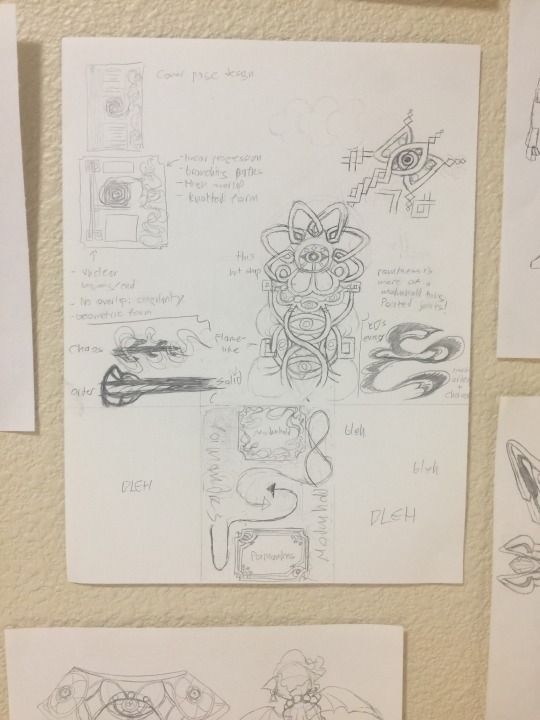
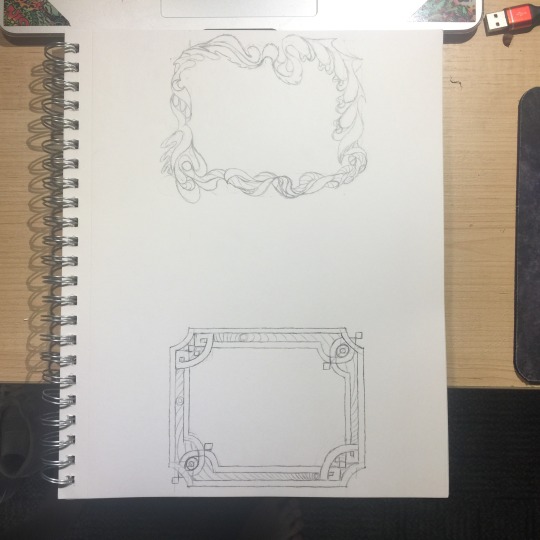

STUDIO UPDATE 3 (three)
Not a huge amount to show, but that’s mostly because I’ve been focused on singular pieces, tweaking, and scriptwriting!
The above images show the process of realizing these two text boxes, the actual creation of which took no less than three hours.
Turns out those fancy exposition pages are a lot of work.
Anyway you can read page 1 of the script below. Summarizing comic pages in text is obtuse.

1 note
·
View note